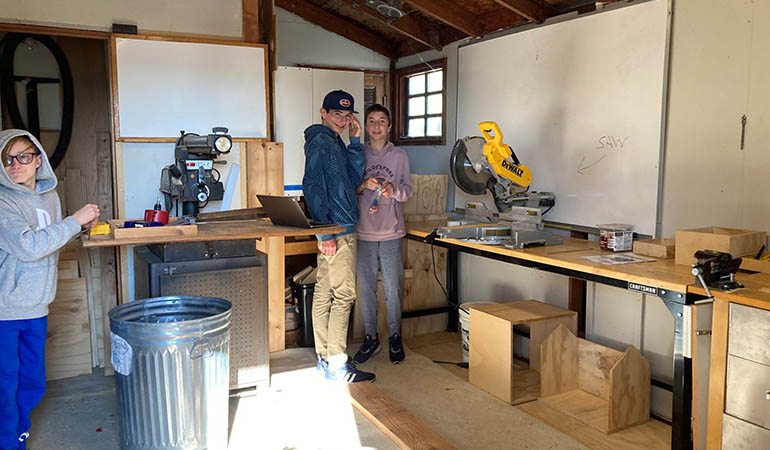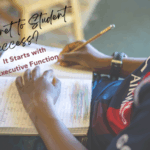In an era where almost everything people do is online, it has never been more important to learn hands-on skills like woodworking and understand basic engineering concepts.
The past few generations have grown accustomed to constantly having new high-tech gadgets and machines. What people don’t completely realize is that there are actual people constantly figuring out ways to design and engineer those products.
I wanted to fix this issue for as many students as I could reach. I was like, “I need to make a class that is super fun and engaging, gives engineering opportunities, and has a cool end product.”
It is my opinion that every kid needs to have real hands-on experience doing projects that involve planning, engineering, building, and testing, throughout their entire school experience. This is the only way for students to be truly engaged in projects to the point where they can have the leadership tools they need to own their learning.
When a Go Kart Is More Than a Go Kart
I wanted to design the class so that students would be personally interested in the project while also learning valuable skills. A lot of students think of shop programs as just another type of boring class. I want to reveal how fun building mechanical devices and engineering actually is.
Marin Montessori’s Junior High sets aside time each week for Creative Expression Classes (CEs). While sometimes adults teach these classes, students can also design and teach them. Earlier this year, I taught a CE each Wednesday for six weeks.
In the first week, I gave the class of ten students a quick overview of the project and what I wanted the end product to look like. As I explained to students, we were going to build a gasoline-powered wooden go-kart from scratch – like REALLY from scratch. Sure, we weren’t planning on milling our own wood, but we were going to do just about everything else.
I then opened up the discussion so that students could provide ideas of how we could go about getting to this point. I think this helped in getting everyone interested and personally involved, which is the key to success with these types of projects.
We needed to first design the look of the kart and how it would function, including all the measurements of parts. Then students would cut the wood to the dimensions specified in the designs.
The most logical (and exciting) next step was to assemble the frame. Then we determined specifications and installed all our hardware, like axles, wheels etc. We wanted the end product to be a functional multi-terrain kart that could be used to transport materials between our school’s farm and garden.
An important idea I used while discussing this project with students was the idea of planning backward. Once we knew what we wanted to have by a certain end date, we could fill in what had to happen each week for us to have success. I think this strategy helped a lot.
After we had planned backward, we could really start the design process step-by-step:
- Design the kart (shape, measurements)
- Make a parts list (wood, hardware)
- Buy the parts (I did that part outside of the class to conserve time)
- Cut the wood parts (this was a great part for student involvement)
- Install hardware (wheels, axle)
- Finishing touches and getting the kart ready for ACTION (the easy part)
Some skills/roles students could be involved in/learn are as follows:
- Engineering and design with CAD programs
- Backward Design Principles
- Using power tools
- Basic woodworking skills
- Basic understanding of how small 2-stroke engines work
CAD programs allow you to model anything in 2D or 3D. Engineers and designers in the real world use these same programs to design products and inventions. Aside from the CAD programs being a blast to use for many students, they can also help with understanding mechanical engineering and concepts. Using these was a must for the class.
While it’s great to have experience in CAD programs to get the feel of digital engineering, to understand certain design principles completely, sometimes you just have to cut some actual wood instead of resizing it digitally.
We learned woodworking skills such as using machines like belt sanders, drill presses, and circular saws safely and correctly. Students got experience with hand tools like hand saws, chisels, and hammers. You would be surprised how many people (including adults) don’t know the proper safety measures to take when using a hand saw.
Most of the students in the class had some previous experience with these kinds of tools, but it was great to introduce a bit more knowledge and let them practice using the tools on a really fun project!
The Takeaways
On reflection of this class, I feel confident that everyone had fun and got valuable experience from working with woodworking tools and CAD/Design programs, learning how engines work, and in general just thinking like an engineer.
I think learning these valuable skills wouldn’t have been possible without the idea of “hands-on learning.” It really helps students dive deep into whatever they are learning and hold onto that information for longer if they’re actually experiencing it in the moment.

Gus is a current student at MMS who values creativity and loves building things. He is very much a hands-on learner. Gus is interested in studying electrical engineering and business in the future. He is really interested in the possibilities of nuclear fusion and enhancing AI technology. In his free time, he likes to do small electronic projects, work on his fully electric custom-built go-kart, or sail on the bay. Gus also produces electronic hip-hop style music.






Sam Shapiro
Really fantastic to read this, Gus! Thanks so much for leading the class and designing it so thoughtfully. I’m impressed with the number of skills you noted this hands on learning project developed for you. How coo too…a fully powered go-kart from scratch!
Bailey
Super cool project! I wish my school would have done things like that…
Michelle Durgy
Amazing job, Gus! What a fantastic opportunity for students to learn so many skills that applicable across various disciplines. Thanks for sharing your expertise with the other students!
Rosalind Hamar
Gus Gossett is a wonderful teacher and engineer and a such a young age! Very impressed!